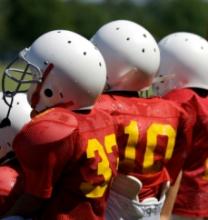
Sports concussion myths are still common, despite increased media focus and education in recent years.
Here are some of the many myths about concussions and the facts.
Myth: A concussion only occurs as a result of a direct blow to the head.
Fact: A concussion may be caused by a direct blow to the head, face, neck, or elsewhere on the body if the force of the impact is transmitted to the head.
Myth: Players suffer concussions only when hit on a particular part of the head and the force of the blow to the head reaches a certain impact magnitude.
Fact::A concussion may be caused by a direct blow to the head, face, neck, or elsewhere on the body if the force of the impact is transmitted to the head.
Myth: It takes a really hard hit to result in concussion
Fact: Concussions occur from blows to different parts of the head and of varying magnitude. A relatively minor impact may result in a concussion while a high-magnitude hit to the head may not. There is therefore no way to know for certain whether a particular blow will lead to a concussion.
Myth: Concussions only occur as a result of a straight-on hit.
Fact: Concussions are caused by two types of forces: linear (a straight-on hit) and rotational (a twisting motion). On virtually every hit to the head, both linear and rotational accelerations are present. Researchers and other experts believe that, of the two, rotational forces, because they cause a rapid "spinning" of the brain, are more injurious.
Myth: Only athletes in aggressive contact sports like football, hockey and lacrosse suffer concussions.
Fact: While football has the highest number of concussions, and concussions are common in hockey, lacrosse and wrestling, concussions also occur frequently in boys' and girls' soccer and basketball, and cheerleading. For the latest statistics on the rates of concussions in high school sports, click here.
Myth: All concussions are the same.
Fact: No two concussions are identical. The symptoms can be very different, depending on a variety of factors, including the degree of force and location of the impact, the degree of metabolic dysfunction, the tissue damage and recovery time, the number of previous concussions sustained by the athlete, and the time between injuries. They do, however, share certain characteristics.
Myth: A concussion occurs only when an athlete experiences a loss of consciousness (LOC).
Fact: Concussions can occur with or without LOC. In fact, the vast majority of concussions (more than 95% in a recent study of concussion among high school athletes do not result in LOC.
Myth: A player who gets "dinged" or has his "bell rung" (e.g. suffers a hit which results in a stunned confusional state that clears up within minutes) hasn't suffered a concussion.
Fact: This is one of the biggest concussion myths. There is no acceptable amount of head contact young athletes can receive without potentially causing a serious brain injury. The fact is that a stunned confusional state is still considered a concussion even though the symptoms may only seem to last for a very short time. Because the signs and symptoms of concussion may not be apparent until several minutes or hours later, with delayed onset of symptoms more common in athletes under age 18, it is essential that a player who has gets dinged be re-evaluated frequently to check to see if a more serious injury has occurred, especially during the first three hours, with a follow-up clinical evaluation and symptom checklist performed at 24 hours post-injury.
Myth:The signs and symptoms of concussion are always apparent immediately after injury.
Fact: While signs of concussion (those characteristics that can be observed by people other than the athlete) and symptoms (experienced by the athlete him or herself) are often present or observable at the time of injury, they may not appear until several hours or even days or weeks later. In fact, delayed onset of signs and symptoms is more likely in younger athletes. Athletes, parents and other caregivers need to be alert to the occurrence of such delayed signs or symptoms or deteriorating mental status, which may signal the presence of a serious, life-threatening brain injury such as subdural hematomas (bleeding on the brain).
Myth: It is safe for a player to return to the same game or practice if he suffers only a brief LOC.
Fact: A player who suffers ANY signs or symptoms of concussion should NOT - and indeed, under the laws of almost all states, MUST not - be allowed to return to the current game or practice no matter how quickly symptoms may clear.
By law in 48 states and the District of Columbia, athletes are now prohibited from same day return to play if a concussion is suspected, with no return to play without written clearance from a medical professional with specialized knowledge of and expertise in concussion evaluation and management.
Myth: It is safe for a player to return to the same game or practice if, after suffering a concussion, he is symptom free within 15 or 20 minutes, both at rest and with exertion.
Fact: A player under age 18 who suffers ANY signs or symptoms of concussion should NOT be allowed to return to the current game or practice no matter how quickly symptoms may clear.
Myth: Concussions suffered by athletes under the age of 18 are managed the same way as concussions suffered by adult athletes.
Fact: Concussions in athletes under age 18 should be managed more conservatively than concussions in college-age and professional athletes, even if the same medical resources are available, and an elite athlete is the patient. It also appropriate to extend the amount of time after the concussion symptoms of an child or adolescent athlete clear before he is allowed to begin practicing and returns to play.
Myth: Most athletes know when they have suffered a concussion and report them to their coach, athletic trainer or team doctor.
Fact: Many athletes do not understand precisely when they have suffered a concussion (many still think that it requires a loss of consciousness), and wouldn't tell the coach even if they knew they had sustained one. The macho culture of sports, particularly in such aggressive contact and collision sports as football, hockey, and boys lacrosse, puts athletes under significant pressure to "shake off" a concussion or "take it like a man" - pressure that coaches and parents often exacerbate, either directly or indirectly or subtly, in their desire for team and individual success - which results in a drastic and chronic underreporting of concussions and can lead to serious harm.
Athletes need to understand the signs and symptoms of a concussion as well as the range of negative consequences of not reporting a concussion, from predisposition to future concussions to long-term cognitive (e.g. memory) and emotional difficulties (e.g. depression), to development of a neurodegenerative condition called chronic traumatic encephalopathy (CTE) that mimicks early Alzheimer's, to catastrophic injury (e.g. second impact syndrome).
Myth: Only athletes that suffer concussions run the risk of suffering adverse long-term health consequences.
Fact: Recent studies establish that not only can concussions lead to postconcussion syndrome and increased risk of long-term cognitive, emotional, and behavioral problems, and have been linked by some experts to chronic traumatic encephalopathy, but emerging research suggests that repeated subconcussive blows may lead to the same problems.
Myth: Mouth guards prevent concussions.
Fact: There is no good clinical evidence that mouthguards prevent concussion. A properly fitted mouth guard, regardless of type (boil-and-bite or custom-made), should nevertheless be worn because of its value in protecting the teeth and preventing fractures and avulsions that could require many years of expensive dental care.
Myth: All football helmets reduce the risk of concussion.
Fact: While helmets have been shown to protect against skull fracture, severe traumatic brain injury, and death, and while biomechanical studies have shown that the use of head gear and helmets can reduce impact forces to the brain and provide more protection against some of the forces that may lead to concussion, there is very little evidence that a particular brand of helmet reduces the incidence of concussion.
Myth: Brand-new football helmets provide more protection against concussion than older helmets.
Fact: According to a new study, the risk of sustaining a concussion in high school football is not affected by the brand or age of the helmet or by the type of mouth guard worn.
For the most comprehensive, up-to-date concussion information on the Internet, click here.



